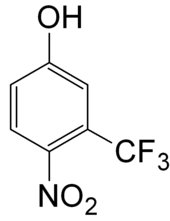TFM (piscicide)
TFM (3-trifluoromethyl-4-nitrophenol) is a common piscicide, i.e., a fish poison used to combat parasitic and invasive species of fish.[1]
 | |
| Names | |
|---|---|
| IUPAC name
4-nitro-3-(trifluoromethyl)phenol | |
| Identifiers | |
3D model (JSmol) |
|
| ChemSpider | |
| ECHA InfoCard | 100.001.653 |
PubChem CID |
|
| UNII | |
CompTox Dashboard (EPA) |
|
| |
| |
| Properties | |
| C7H4F3NO3 | |
| Molar mass | 207.108 g·mol−1 |
Except where otherwise noted, data are given for materials in their standard state (at 25 °C [77 °F], 100 kPa). | |
| Infobox references | |
The substance was discovered in 1958 when researching means to combat sea lampreys and it currently remains the primary lampricide (lamprey-killer) in the Great Lakes area.[1]
TFM toxicity has not been thoroughly investigated for humans, but is considered an irritant, respiratory irritant, and toxic by the manufacturer[2]. Toxicity studies of other mammals have generally found it to be non-toxic at concentrations expected to be found in treated areas . Impact on other fish species may be controlled by selective application during the larvae season for lampreys and other management of its concentration. TFM does not accumulate, since it breaks down within several days. [1]
References
- TFM fact sheet
- Pfaltz & Bauer. 2014. Safety Data Sheet. 3-Trifluormethyl-4-Nitrophenol. Product code T23635